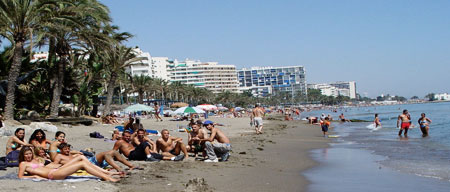Home > Study in Spain > City Guide > Marbella
Marbella City Guide
- Places of Interest
- Maps
- Getting to
- Getting around the city
Best known as a playground for the rich and famous, Marbella has so much more to offer than simply celebrity spotting and overpriced champagne. Home to some of the most beautiful beaches in Spain, as well as a plethora of leisure activities, including top class golf courses and tennis courts, Marbella is certainly a place to come if you like to live the high life. However, Marbella is not totally bereft of cultural activities; the town houses a number of museums, as well as sights such as sculptures by Dali and a fascinating Arabic Wall. Despite having a reputation for being a place colonised by tourists, Marbella has managed to retain some of its original Andalusian charm; mainly in its delicious cuisine.
Although there is archaeological evidence of the existence of a settlement in the mountains around Marbella as far back as Paleolithic times, the name Marbella, derived from Marbil-la, dates from Islamic rule, when Muslims built a castle in the town and a wall around it. In 1485, the Spaniards reconquered Marbella and the city grew in the following centuries. In the 1940s, Marbella was a tiny village of only 900 inhabitants, but a chance encounter with Prince Max Egon zu Hohenlohe-Langenburg changed its fortune. His Rolls Royce broke down in the area and he was so struck by its beauty that he decided to buy land there and market it as a tourist destination. In 1954, he opened the Marbella Club Hotel, and the town has been on the up ever since.
Perfectly located in a beautiful setting with both the sea and the mountains, and with a wonderfully warm climate and nightlife to die for, Marbella really is a fabulous place to be. Go and check out the museums or enjoy the scenery, even if that scenery is just the wonderfully extravagant boats docked at the marina at Puerto Banús!
Places of Interest
Capilla de San Juan de Dios
A 16th century building, with a beautiful stone door decorated in a gothic style.
Ermita de Santiago
Considered to be the oldest religious building in Marbella, dating back to the 15th century, at the time of the Spanish reconquest of the town.
Ayuntamiento
Striking features include a solar clock and coats of arms made of stone commemorating the extension of the building and the bringing of water to public fountains. There is also a beautiful wide iron balcony, door in the Mudejar Muslim style and a series of murals on the walls.
Arabic Wall
Built in the 10th century, after the rebellion of Omar Ben Hafsun, in order to prevent further invasions. Built with materials from a nearby Roman building. After the Spanish reconquest in 1485, it underwent reforms in order to adapt it to artillery attack.
Termas Romanas
Dating back to the 3rd century, these Roman Thermae were discovered in 1926. N.B. Visits are currently suspended until further notice.
The Golden Mile
A stretch along the coastland featuring buildings such as the late King Fahad's palace and the Marbella Club Hotel, the hotel which established Marbella's exclusive reputation, and in its golden age had guests such as Audrey Hepburn, Ava Gardner, Cary Grant and Laurence Olivier.
Parks
Jardín Botánico El Ángel
Its main attraction is the richness and antiquity of its species of trees. Situated in the El Ángel colony.
Parque de la Constitución
The park that has everything. Beautifully kept grass, a children's playpark, a small observatory, a stage for shows and and concerts and even a bar. Perfect when looking for a bit of tranquility away from the town.
Avenida del Mar
Its entrance is adorned with fountains, pergolas and a collection of 10 sculptures by Salvador Dalí.
Maps
Getting to Marbella
By Air
The closest airport is in Malaga, and from there you can easily get a car, bus or taxi to Marbella.
By Bus
There is a bus station in Marbella which advertises itself as: "From Marbella bus station you can go anywhere in the world"!
By Train
Although Marbella itself does not have a train station, nearby Fuengirola is connected to Malaga airport and is one of the main portals into Andalucia from other places in Spain.
Getting around the city
There is a bus system in Marbella, but the best way to get around is either by car or scooter. Taxis are very popular in Marbella as they are convenient and easy to find. It is customary to give taxi drivers a small tip when paying.
Tips
Quality of life in Marbella is fantastic, although obviously its exclusivity means prices can be very high, although not as high as city centres such as Madrid or Barcelona. Many people feel that Marbella presents greater value for money than other places in Spain. As with all Spanish cities, watch out for pickpockets and bag-snatchers.

